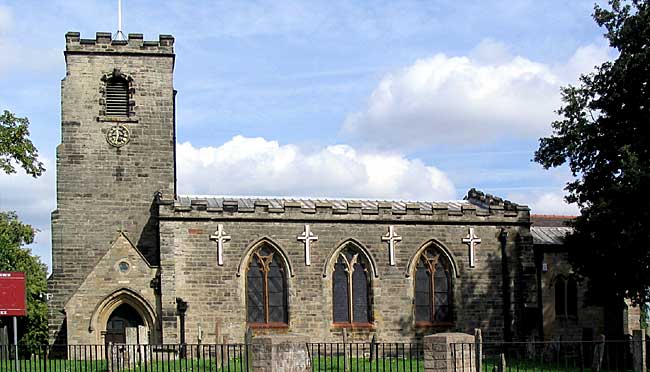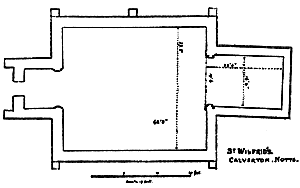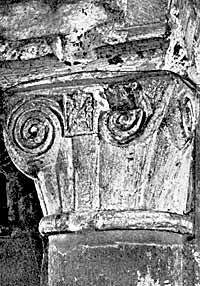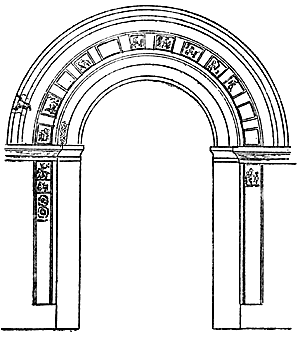Calverton church
By the Rev. A. Du Boulay Hill.

The Church of St. Wilfrid, Calverton.

The Church of St. Wilfrid, Calverton, Notts., consists of a chancel, a nave of the unusual form of a wide parallelogram 42ft. 8in. x 37ft. 2in., of one span and with no trace of arcades, and a western tower forming the only entrance to the church, until a south porch was added in 1881.
I consider it probable that the church was entirely rebuilt in the 14th century with the materials of a previously existing Norman church, many of the stones of which, with worked surfaces and incised patterns, may be seen externally in the chancel walls and lower courses of the nave.
In 1760-63 the nave was rebuilt from its lower courses, or at any rate the walls refaced, and the whole embellished with a set of round-headed windows of the fashion of that time.
The interest of this church consists in the remains of the Norman work, which have been utilized in various ways. The chancel, the axis of which inclines to the south, opens to the nave by a plain 14th century arch of two chamfered orders, resting on older piers of the 12th century Norman work with bold and effective triple-grouped shafts, the easternmost forming a respond imbedded in the chancel wall.
You will notice that the arch is not in the centre of the east wall of the nave, but 5ft. nearer the north side. This together with the great width, over 14ft., seems to suggest that while the south pier was probably left in situ, the north pier was rebuilt further north when the present arch was erected.
The Norman piers have a square abacus with a hollow chamfer beneath, and a long fluted capital with neck-mould and large volutes at the angles.
 Capital, Calverton church.
Capital, Calverton church.Between the volutes on the central capital on the north side is a remarkable piece of sculpture, discovered by the late vicar, Rev. T. Woollen Smith, in 1874, on removing the whitewash from the capital. It is a small panel 3in. x 4in., containing a three-quarter length figure of a bearded bishop, seated, as shown by the folds of drapery over the knees, wearing a short broad mitre, and holding a pastoral staff surmounted by a cross in his left hand, while his right hand is raised with three fingers extended in benediction, on his left stands a small naked figure, with crossed arms. The bishop is probably St. Wilfrid, in whose name the church is dedicated, who was consecrated Bishop of York in 664, and died Bishop of Hexham in 709. The figure at his side may be a newly baptised convert, but since the freeing of slaves was a distinguishing feature of the bishop's career, the episcopal act of manumission is perhaps here represented.
The capital has been partly cut away for the insertion of a support to a rood beam, in such a way as to avoid injury to the panel, and to leave it visible from the nave. The veneration with which it was doubtless regarded has been the means of preserving this interesting feature of the church.

There are other sculptured stones of even greater interest, relics of the ornamentation of the destroyed Norman church, to be seen high up in the third stage of the tower, imbedded in a horizontal course on the inner face of the west wall. They bear upon them representations of the various occupations of the months of the year. Seven of these stones are voussure-shaped, and must have formed part of a band of ornament 9in. wide on the architrave of an arch with a radius of about 5ft. to their outer edge. An eighth stone is rectangular, as also is a ninth, to be seen in the north wall of the tower near the ground outside: these would belong to a continuation of the band of ornament down the jambs of the arch. Each panel has its own border, and a semicircular arch of the dimensions given above would give ample room for twelve months to be represented on a Norman doorway about 6ft. in width. The magnificent Norman porch of St. Margaret's, York, with the elaborate carvings of the signs of the zodiac, may be known to some, and we may picture the predecessor of the present Calverton Church as possessing the striking feature of a western porch adorned with these interesting carvings, which I assign to the early part of the 12th century.
